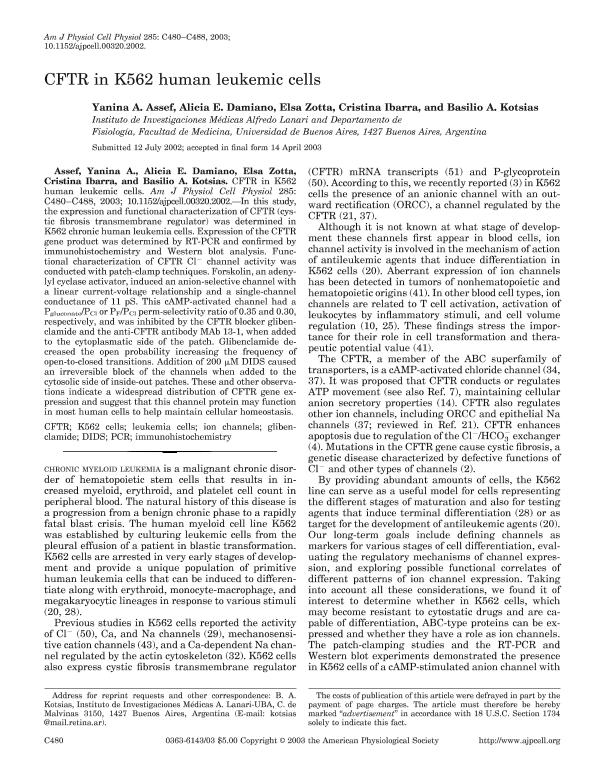Artículo
CFTR in K562 human leukemic cells
Assef, Yanina Andrea ; Damiano, Alicia Ermelinda
; Damiano, Alicia Ermelinda ; Zotta, Elsa; Ibarra, Cristina Adriana
; Zotta, Elsa; Ibarra, Cristina Adriana ; Kotsias, Basilio Aristides
; Kotsias, Basilio Aristides
 ; Damiano, Alicia Ermelinda
; Damiano, Alicia Ermelinda ; Zotta, Elsa; Ibarra, Cristina Adriana
; Zotta, Elsa; Ibarra, Cristina Adriana ; Kotsias, Basilio Aristides
; Kotsias, Basilio Aristides
Fecha de publicación:
08/2003
Editorial:
American Physiological Society
Revista:
American Journal of Physiology-cell Physiology
ISSN:
0363-6143
Idioma:
Inglés
Tipo de recurso:
Artículo publicado
Clasificación temática:
Resumen
In this study, the expression and functional characterization of CFTR (cystic fibrosis transmembrane regulator) was determined in K562 chronic human leukemia cells. Expression of the CFTR gene product was determined by RT-PCR and confirmed by immunohistochemistry and Western blot analysis. Functional characterization of CFTR Cl channel activity was conducted with patch-clamp techniques. Forskolin, an adenylyl cyclase activator, induced an anion-selective channel with a linear current-voltage relationship and a single-channel conductance of 11 pS. This cAMP-activated channel had a Pgluconate/PCl or PF/PCl perm-selectivity ratio of 0.35 and 0.30, respectively, and was inhibited by the CFTR blocker glibenclamide and the anti-CFTR antibody MAb 13-1, when added to the cytoplasmatic side of the patch. Glibenclamide decreased the open probability increasing the frequency of open-to-closed transitions. Addition of 200 uM DIDS caused an irreversible block of the channels when added to the cytosolic side of inside-out patches. These and other observations indicate a widespread distribution of CFTR gene expression and suggest that this channel protein may function in most human cells to help maintain cellular homeostasis.
Archivos asociados
Licencia
Identificadores
Colecciones
Articulos(IDIM)
Articulos de INST.DE INVEST.MEDICAS
Articulos de INST.DE INVEST.MEDICAS
Articulos(OCA HOUSSAY)
Articulos de OFICINA DE COORDINACION ADMINISTRATIVA HOUSSAY
Articulos de OFICINA DE COORDINACION ADMINISTRATIVA HOUSSAY
Citación
Assef, Yanina Andrea; Damiano, Alicia Ermelinda; Zotta, Elsa; Ibarra, Cristina Adriana; Kotsias, Basilio Aristides; CFTR in K562 human leukemic cells; American Physiological Society; American Journal of Physiology-cell Physiology; 285; 2; 8-2003; C480-C488
Compartir
Altmétricas



